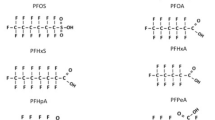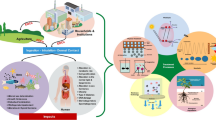Abstract
Trichloroethylene (TCE) and its metabolite trichloroacetic acid (TCA) are ubiquitous environmental contaminants which have been regarded as risk factors for congenital heart malformations. An increasing body of evidence from in vivo and in vitro studies supports the notion that exposure to TCE and TCA may interfere with normal embryonic heart development. The expression of several genes coding for factors implicated in the regulation of cardiac development has been shown to be modified by TCE or TCA, but the molecular mechanisms that mediate these effects are still obscure. In this study, we investigated the global changes in gene expression caused by exposure of P19 embryonal carcinoma cells to TCE and TCA, and whether or not TCE and/or TCA influence the expression levels of genes encoding for proteins that regulate calcium fluxes in cardiac cells. We report that TCE and TCA disrupt the expression of genes involved in processes important during embryonic development suggesting that exposure to environmentally significant concentrations of TCE may have deleterious effects on specific stages of cardiac differentiation.



Similar content being viewed by others
References
Goldberg, S. J., Lebowitz, M. D., Graver, E. J., & Hicks, S. (1990). An association of human congenital cardiac malformations and drinking water contaminants. Journal of the American College of Cardiology, 16(1), 155–164.
Yauck, J. S., Malloy, M. E., Blair, K., Simpson, P. M., & McCarver, D. G. (2004). Proximity of residence to trichloroethylene-emitting sites and increased risk of offspring congenital heart defects among older women. Birth Defects Research. Part A, Clinical and Molecular Teratology, 70(10), 808–814.
Johnson, P. D., Dawson, B. V., & Goldberg, S. J. (1998). Cardiac teratogenicity of trichloroethylene metabolites. Journal of the American College of Cardiology, 32(2), 540–545.
Johnson, P. D., Dawson, B. V., & Goldberg, S. J. (1998). A review: Trichloroethylene metabolites: Potential cardiac teratogens. Environmental Health Perspectives, 106(4), 995–999.
Fisher, J. W., Channel, S. R., Eggers, J. S., Johnson, P. D., MacMahon, K., Goodyear, C. D., Sudberry, G. L., Warren, D. A., Latendresse, J. R., & Graeter, L. J. (2001). Trichloroethylene, trichloroacetic acid, and dichloroacetic acid: Do they affect fetal rat heart development? International Toxicological Sciences, 20, 257–267.
Hardin, B. D., Kelman, B. J., & Brent, R. L. (2005). Trichloroethylene and dichloroethylene: A critical review of teratogenicity. Birth Defects Research. Part A, Clinical and Molecular Teratology, 73(12), 931–955.
NAS (2006) Assessing the human health risks of trichloroethylene: Key scientific issues. Committee on human health risks of trichloroethylene, National Research Council. National Academies Press. http://www.nap.edu.
Drake, V. J., Koprowski, S. L., Lough, J. W., Hu, N., & Smith, S. M. (2006). Trichloroethylene exposure during cardiac valvuloseptal morphogenesis alters cushion formation and cardiac hemodynamics in the avian embryo. Environmental Health Perspectives, 114, 842–847.
Mishima, N., Hoffman, S., Hill, E. G., & Krug, E. L. (2006). Chick embryos exposed to trichloroethylene in an ex ovo culture model show selective defects in early endocardial cushion tissue formation. Birth Defects Research. Part A, Clinical and Molecular Teratology, 76(7), 517–527.
Boyer, A. S., Finch W. T., & Runyan, R. B. (2000). Trichloroethylene inhibits development of embryonic heart valve precursors in vitro. Toxicological Sciences, 53, 109–117.
Ou, J., Ou, Z., McCarver, D. G., Hines, R. H., Oldham, K. T., Ackerman, A. W., & Pritchard, K. A., Jr. (2003). Trichloroethylene decreases heat shock protein 90 interactions with endothelial nitric oxide synthase: Implications for endothelial cell proliferation. Toxicological Sciences, 73, 90–97.
Shafer, T. J., Bushnell, P. J., Benignus, V. A., & Woodward, J. J. (2005). Perturbation of voltage-sensitive Ca++ channel function by volatile organic solvents. JEPT, 18 August. doi:10.1124/JPET.105.090027.
Hoffmann, P., Heinroth, K., Richards, D., Plews, P., & Toraason, M. (1994). Depression of calcium dynamics in cardiac myocytes—a common mechanism of halogenated hydrocarbon anesthetics and solvents. Journal of Molecular Cell Cardiology, 26(5), 579–589.
Collier, J. M., Selmin, O., Johnson, P. D., & Runyan, R. B. (2003). Trichloroethylene effects on gene expression during cardiac development. Birth Defects Research. Part A, 67, 488–495.
Selmin, O., Thorne, P. A., Caldwell, P. T., Johnson, P. D., & Runyan, R. B. (2005). Effects of trichloroethylene and its metabolite trichloroacetic acid on the expression of vimentin in the rat H9C2. Cell Biology and Toxicology, 21, 83–95.
Davidson, I. W. F., & Beliles, R. P. (1991). Consideration of the target organ toxicity of trichloroethylene in terms of metabolite toxicity and pharmacokinetics. Drug Metabolism Review, 23, 493–599 (Marcel Dekker Inc., New York).
Bayer, K. U., Löhler, J., Schulman, H., & Harbers, K. (1999). Developmental expression of the CaM kinase II isoforms: Ubiquitous g and d-CaM kinase II are the early isoforms and most abundant in the developing nervous system. Molecular Brain Research, 70, 147–154.
Liu, H., Harris, T. M., Kim, H. H., & Childs, G. (2005). Cardiac myocyte differentiation: The Nkx2.5 and Cripto target genes in P19 clone 6 cells. Functional & Integrative Genomics, 5, 218–239.
Szyf, M., Theberge, J., & Bozovic, V. (1996). Ras induces a general demethylation activity in mouse embryonal P19 cells. The Journal of Biological Chemistry, 279(21), 12690–12696.
Nakajima, T., Wang, R. S., Elovaara, E., Park, S. S., Gelboin, H. V., & Vainio, H. (1993). Cytochrome P450-related differences between rats and mice in the metabolism of benzene, toluene and trichloroethylene in liver microsomes. Biochemical Pharmacology, 9;45(5), 1079–1085.
Halmes, N. C., Samokyszyn, V. M., & Pumford, N. R. (1997). Covalent binding and inhibition of cytochrome P4502E1 by trichloroethylene. Xenobiotica, 27(1), 101–110.
Bronley-DeLancey A., McMillan, D. C., McMillan, J. M., Jollow, D. J., Mohr, L. C., & Hoel, D. G. (2006). Application of cryopreserved human hepatocytes in trichloroethylene risk assessment: Relative disposition of chloral hydrate to trichloroacetate and trichloroethanol. Environmental Health Perspectives, 114(18), 1237–1242.
Hard, A. L., Abdolell, M., Robinson, B. H., & Koren, G. (2005). Gene-expression analysis after alcohol exposure in the developing mouse. The Journal of Laboratory and Clinical Medicine, 145(1), 48–54.
Deltour, L., Ang, H. L., & Duester, G. (1996). Ethanol inhibitor of retinoic acid synthesis as a potential mechanism for fetal alcohol syndrome. The FASEB Journal, 10(9), 1050–1057.
Reen, R. K., Dombkowski, A. A., Kresty, L. A., Cukovic, D., Mele, J. M., Salagrama, S., Nines, R., & Stoner, G. D. (2007). Effects of phenyl isothiocyanate on early molecular events in N-nitrosomethylbenzylamine-induced cytotoxicity in rat esophagus. Cancer Research, 67(13), 6484–6492.
Wang, J. L., Chen, W. L., Tsai, S. Y., Sung, P. Y., & Huang, R. N. (2001). An in vitro model for evaluation of vaporous toxicity of trichloroethylene and tetrachloroethylene to CHO-K1 cells. Chemico-biological Interactions, 137, 139–154.
Moreno, R. L., Goosen, T., Kent, U. M., Chung, F. L., & Hollenberg, P. F. (2001). Differential effects of naturally occurring isothiocyanates on the activities of cytochrome P4502E1 and the mutant P4502E1 T303A. Archives of Biochemistry and Biophysics, 391(1), 99–110.
Nakajiama, M., Yoshida, R., Shimada, N., Yamazaki, H., & Yokoi, T. (2001). Inhibition and inactivation of human cytochrome P450 isoforms by phenethyl isothiocyanate. Drug Metabolism and Disposition, 29(8), 1110–1113.
Pozzi, S., Rossetti, S., Bistulfi, G., & Sacchi, N. (2006). RAR-mediated epigenetic control of the cytochrome P450 Cyp26a1 in embryocarcinoma cells. Oncogene, 25, 1400–1407.
Kim, D., & Ghanayem, B. I. (2006). Comparative metabolism and disposition of trichloroethylene in Cyp2e1−/− and wild-type mice. Drug Metabolism and. Disposition, 34(12), 2020–2027.
Caldwell, J. C., Keshava, N., & Evans, M. V. (2007). Difficulty of mode of action determination for trichloroethylene: An example of complex interactions of metabolites and other chemical exposures. Environmental and Molecular Mutagenesis Review Article. doi:10.1002/em.20350.
MacDonald, J. L., Gin, C. S. Y., & Roskams, A. J. (2005). Stage-specific induction of DNA methyltransferases in olfactory receptor neuron development. Developmental Biology, 288, 461–473.
Sharma, P., Senthilkumar, R. D., Brahmachari, V., Sundaramoorthy, E., Mahajan, A., Sharma, A., Sengupta, S. (2006). Mining literature for a comprehensive pathway analysis: A case study for retrieval of homocysteine related genes for genetic and epigenetic studies. Lipids in Health and Disease, 5, 1–19.
Dow, J. L., & Green, T. (2000). Trichloroethylene induced vitamin b12 and folate deficiency leads to increased formic acid excretion in the rat. Toxicology, 146, 123–136.
Tao, L., Yang, S., Xie, M., Kramer, P. M., & Pereira, M. A. (2000). Effect of trichloroethylene and its metabolites, dichloroacetic acid and trichloroacetic acid, on the methylation and expression of c-jun and c-myc protooncogenes in mouse liver: Prevention by methionine. Toxicological Sciences, 54, 399–407.
Balke, C. W., & Shorofsky, S. R. (1998). Alteration in calcium handling in cardiac hypertrophy and heart failure. Cardiovascular Research, 37(2), 290–299 (review).
Frey, N., McKinsley, T. A., & Olson, E. N. (2000). Decoding calcium signals involved in cardiac growth and function. Nature Medicine, 6(11), 1221–1227 (review).
Porter, G. A., Jr., Makuck, R. F., & Rivkees, S. A. (2003). Intracellular calcium plays an essential role in cardiac developments. Developmental Dynamics, 227(2), 280–290.
Xu, M., Welling, A., Paparisto, S., Hofmann, F., Klugbauer, N. (2003). Enhanced expression of L-type Cav1.3 calcium channels in murine embryonic hearts from cav1.2-deficient mice. The Journal of Biological Chemistry, 278(42), 40837–40841.
Fukushima, S., Kinoshita, A., Puatanachokchai, R., Kushida, M., Wanibuchi, H., & Morimura, K. (2005). Hormesis and dose-response-mediated mechanisms in carcinogenesis: Evidence for a threshold in carcinogenicity of non-genotoxic carcinogens. Carcinogenesis, 26(11), 1835–1845.
Ai, X., Curran, J. W., Shannon, T. R., Bers, D. M., & Pogwizd, S. M. (2005). Ca2+/calmodulin-dependent proteinase kinase modulates cardiac ryanodine receptor phosphorylation and sarcoplasmic reticulum Ca2+ leak in heart failure. Circulation Research, 97(12), 1314–1322.
Drake, V. J., Koprowski, S. L., Hu, N., Smith, S. M., & Lough, J. (2006). Cardiogenic effects of trichloroethylene and trichloroacetic acid following exposure during heart specification of avian development. Toxicological Sciences, 94(1), 153–162.
Acknowledgments
This research was supported by NIH, SBPR Program No. P42ES04940. Thanks to GE Healthcare Codelink for the microarrays, to George Watts of the Microarray Facility and BioInformatic Service of the SWEHSC (NIH, NIEHS Grant No. ES06694), University of Arizona for carrying out the microarray analysis and help in analyzing the data. Thanks to the Honors College of the University of Arizona, for supporting MT.
Author information
Authors and Affiliations
Corresponding author
Rights and permissions
About this article
Cite this article
Selmin, O.I., Thorne, P.A., Caldwell, P.T. et al. Trichloroethylene and Trichloroacetic Acid Regulate Calcium Signaling Pathways in Murine Embryonal Carcinoma Cells P19. Cardiovasc Toxicol 8, 47–56 (2008). https://doi.org/10.1007/s12012-008-9014-2
Received:
Accepted:
Published:
Issue Date:
DOI: https://doi.org/10.1007/s12012-008-9014-2




